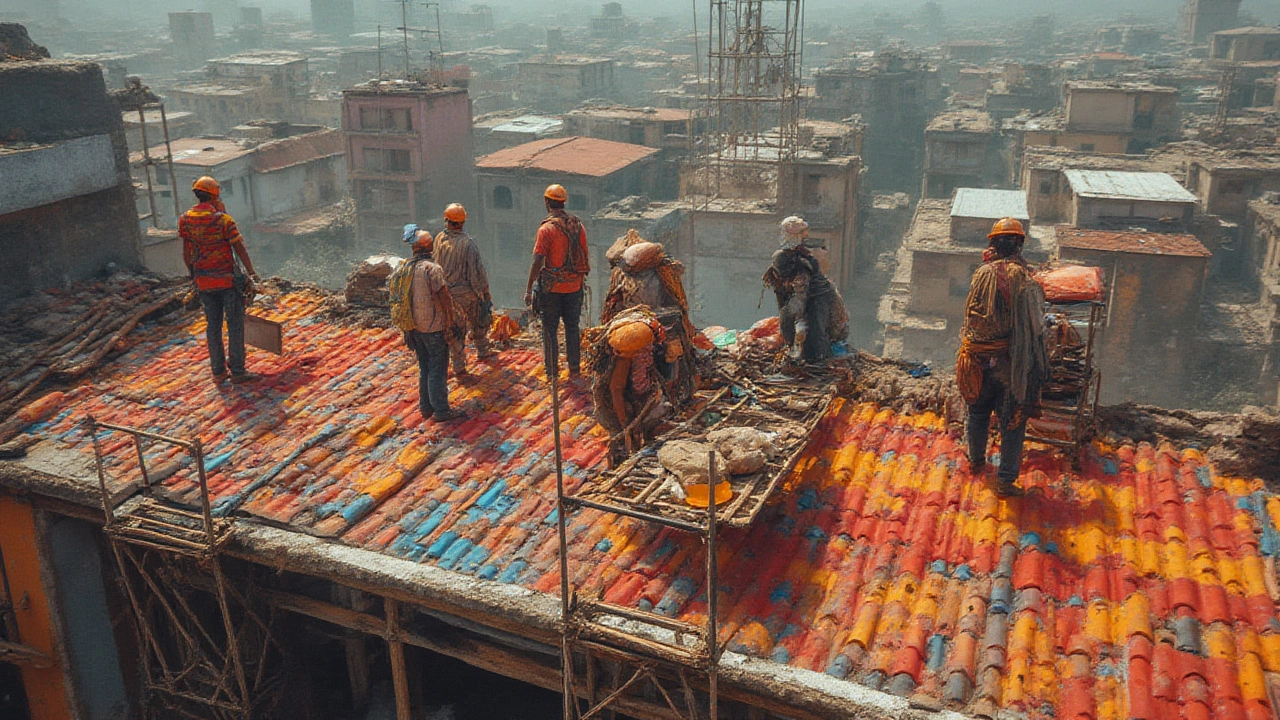You see the number on the estimate and feel your stomach hit the floor. $15,000 for a new roof? That can be more than some cars. But roofs are up there roasting in the sun, soaked by rain, battered by storms, and silently doing their job. Why does it hurt so much when the bill comes? If you’ve ever watched a crew tear off old shingles on a scalding day while you sip coffee from your air-conditioned kitchen, you already know roofing is tough work. But there’s a lot more to the sticker shock than just sweat and shingles. Let’s dig into the real reasons why roof work is so expensive—no sugarcoating or smooth sales talk, just straight-up facts from someone who’s obsessed over every bill in his own home.
The True Cost of Roofing Materials and Why They Keep Rising
Your roof is made of more than just a few planks and some waterproof coating. Take asphalt shingles, for example; they’re the most common roofing choice in the U.S., but even the cheapest ones are creeping toward $120 per square (that’s a 10-foot by 10-foot patch). Premium shingles, metal roofing, or tile? Now you’re often talking $300 to $1,000 per square. It gets crazier when you factor in the rest—underlayment, ice shields, flashing, ridge caps, nails, and vent boots. It’s like ordering a burger and realizing you have to pay separately for the bun, meat, lettuce… and the plate.
Why are materials getting more expensive every year? Blame a little thing called supply chain madness. During the pandemic, factories slowed down or shut off while storms kept tearing up roofs. Prices jumped not just for shingles, but for lumber and even basic metal fixtures—those price hikes haven’t come down much since. Manufacturers like GAF or Owens Corning have issued price increase announcements two or three times a year lately.
Then, there’s shipping. A random hailstorm in Texas or a hurricane in Florida can make prices pop overnight across the country due to demand spikes. If you’re unlucky enough to own an old home like I do, you may also need decking replacement—plywood prices spiked 252% in 2021, and they're still more than double what they were five years ago. Nobody tells you this when you buy the house.
| Material | 2020 Avg. ($/square) | 2024 Avg. ($/square) |
|---|---|---|
| Asphalt Shingles | $90 | $120 |
| Metal Roofing | $350 | $640 |
| Clay Tiles | $650 | $940 |
It’s easy to see how every layer of your roof adds up fast. So next time your contractor mutters about material costs, he’s not making it up. He’s probably crossing his fingers the price doesn’t jump before your job starts.
Labor That’s Worth Every Penny—But Why So Much?
If you’ve ever picked up a shingle, you know those things have weight. Now imagine yanking off hundreds, sometimes thousands, of them, then hauling up fresh bundles and laying them down in the blazing sun, all while perched above the ground with nothing but air below. Roofing is one of the toughest, most physically demanding jobs in construction, and honestly, not many folks want to do it.
This means roofing contractors can’t just put an ad in the paper and find 20 people ready to work. The U.S. Bureau of Labor Statistics says skilled roofers still earn around $23 per hour on the low end, but for experienced crews or specialty jobs, it’s often $35 or more—for each worker, not just the boss. And roofing requires a team, not a lone wolf. Safety rules in 2025 are stricter too; OSHA fines are sky high, and crews now wear extra harnesses, ropes, and special shoes.
Plus, every roofing company pays a hefty price for workers’ comp insurance. Roofing is ranked among the top five most dangerous jobs in America, right up there with loggers and fishermen. One slip, and lawsuits or hospital bills can sink a business. Most companies pay 15%–50% of each dollar they pay out in wages back to insurance—yes, nearly half! Tack on busy season overtime, job training, and checking every guy has up-to-snuff paperwork (especially after the labor shortages coming out of 2023), and it’s no wonder labor is often half or more of your total bill.
Ever notice how some roofing jobs go way over estimate? Sometimes that’s because crews hit unexpected rot, ancient vent stacks, or even honeybee nests (yes, it happens more than you’d think), and the labor clock keeps ticking. When you pay for roof work, you pay for muscle, experience, and plenty of sweaty grit.

Permits, Codes, and Red Tape: The Hidden Fees Stealing Your Wallet
Even paradise neighborhoods want a slice of your roofing cost. Every city and county seems to have its own set of rules. Want to put a new roof on a 100-year-old house? You’ll need permits—and they aren’t free. Depending on where you live, a roofing permit can run from $150 to over $1,300, sometimes more if you’re in a historic district or your city just decided it’s time to “update” the code requirements again.
Your roofer has to play by those rules, too. Building codes keep getting stricter each year, mostly because of wild weather. For instance, Miami-Dade County requires shingles nailed six times, with special wind straps, impact barriers, and hurricane clips. If you live in a snowy place, your city might also force you to add extra ice and water shields. These aren’t “nice to have” options—they’re the law, and skipping steps means major fines or redoing the job. Roofers spend more time waiting for inspectors and less time swinging hammers. If the city’s busy, inspections can delay a job for a week or more, and you foot the bill for those lost workdays.
The paperwork trail doesn’t end with the city. Most jobs need bonds, insurance certificates, and product warranties spelled out in contracts. Many homeowners’ associations pile on their own rules about color, style, and noise hours. It gets so complicated that some roofers hire folks just to manage the forms. When your roofer includes a “service fee” or “admin charge,” it’s often not a hustle—it’s survival in a paperwork jungle nobody warned you about.
How to Save Money and Avoid Getting Burned
All these reasons might make you want to scream, tear off the remaining shingles yourself, and go gray for the rest of your life. But hang in there—there are ways to get the job done without selling your soul. Start by getting at least three quotes, and make sure each covers the same scope of work. I once had a contractor lowball the cost by “forgetting” the price for tearing off old layers. It’s a classic trick that comes back to bite when you get the final bill.
Ask your roofer to break down the estimate—materials, labor, permits, and extras should be listed clearly. Don’t be afraid to question line items. In my case, Nina grilled our contractor about ventilation upgrades until he showed her exactly what was getting replaced. Don’t just pick the cheapest bid either: reputable roofers offer solid warranties (look for at least 15 years on labor, 25 on materials) and use materials rated well for your climate, not sloppy leftovers from another job.
You can also shave thousands off your bill by timing your replacement. Fall and late winter are slower for most roofers (unless you live in Florida, where everything’s a madhouse). If you can book during these off-peak windows, you might score a better rate. Some companies even offer early-bird discounts if you lock in jobs before materials prices go up for the season.
- Check if your insurance covers hidden damage (water leaks or storm hits—file claims fast)
- Invest in preventive maintenance, like cleaning gutters and trimming overhanging branches
- Use social proof—get references, check reviews, see the quality of your roofer’s previous work
- Verify certifications—are they GAF or CertainTeed certified? These guys know their stuff and play by the rules
One sneaky trick I used: double-check every material delivery to make sure what’s on the truck matches what’s on the bid. Sometimes substitutes happen, and you shouldn’t pay Cadillac prices for Chevys.
Here’s something wild: According to the National Roofing Contractors Association, nearly one in five homeowners who hired the lowest bidder re-hired someone else to fix shoddy work within three years. It hurts more in the long run. Cheap roofs fail fast—there’s no getting around it. Quality work costs money, but done right, your roof can last 20 to 50 years, depending on the material.
Roofing isn’t just a fancy hat for your home. It’s the shield that stands between you, your loved ones, and the weather. If it seems pricey, remember—you’re not just paying for stuff, or even just the hands that put it together. You’re paying for peace of mind, for years’ worth of worry-free sleep, and for the simple joy of watching rain bounce off shingles from inside your warm, dry living room. Costly? Yeah. Worth it? Every single time.
